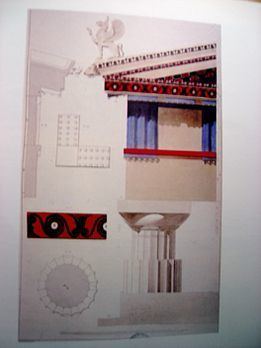Name Guillaume-Abel Blouet Role Architect | ||
 | ||
Died May 7, 1853, Paris, France People also search for Louis-Robert Goust, Jean-Nicolas Huyot, Jean Chalgrin, Jean-Arnaud Raymond | ||
Guillaume-Abel Blouet (6 October 1795 – 7 May 1853) was a French architect who specialised in prison design.
Contents

Biography
Blouet was born at Passy. He won the Grand Prix de Rome in 1821 at the École des Beaux-Arts, entitling him to five years' study at the French Academy in Rome. The study of Roman architecture that was expected from students at the French Academy at Rome resulted in his speculative restoration of the original construction of the Baths of Caracalla, Restauration des thermes d'Antonin Caracalla, à Rome, présentée en 1826 et dédiée en 1827 à l'Académie des Beaux-Arts (1828).
The Institut de France appointed Blouet the head of the fine arts section of the French Morea expedition 1828-1833, the second of three great military-scientific expeditions led by France in the first half of the 19th century, in which geologists and antiquarians accompanied an expedition with military objectives, in this case to deport all Ottoman nationals from the Morea, a turning-point in the Greek War of Independence. In the course of the expedition he established the identity of the Temple of Zeus at Olympia (1829), which was measured and carefully drawn and published.
Having overseen the completion of the Arc de Triomphe (1831–36), he toured the United States in 1836, together with Frédéric-Auguste Demetz, a penal reformer and lawyer at the French Royal Court, to study American prison architecture and administration for the French Ministry of the Interior.
Upon Blouet's return to Paris he devoted himself to the reform of prison design and in 1838 was appointed to the new post of Inspector General of French Prisons, which brought with it, ex officio, a seat on the Conseil des bâtiments civiles, the official national body that succeeded the Bâtiments du Roi of the Ancien Régime. Blouet believed in using architecture to realize social reform and together with Demetz worked on the design and layout of the buildings for the Mettray Penal Colony, an agricultural reform school, which was initially directed by Demetz after its opening in July 1839. It was noted as being officially opened on 22 January 1840.
In 1846 he was appointed a professor at the École nationale supérieure des Beaux-Arts and in 1848, when his post of Inspector General of Prisons was eliminated in a reorganization, he was given in compensation the position of architect in charge of the Palais de Fontainebleau, which was to be a center of court life under the French Second Empire. He revised and completed the Traité théorique et pratique de l'art de bâtir of Jean-Baptiste Rondelet (1847). He was elected to the Académie des Beaux-Arts in 1850.
He died in Paris in 1853.
